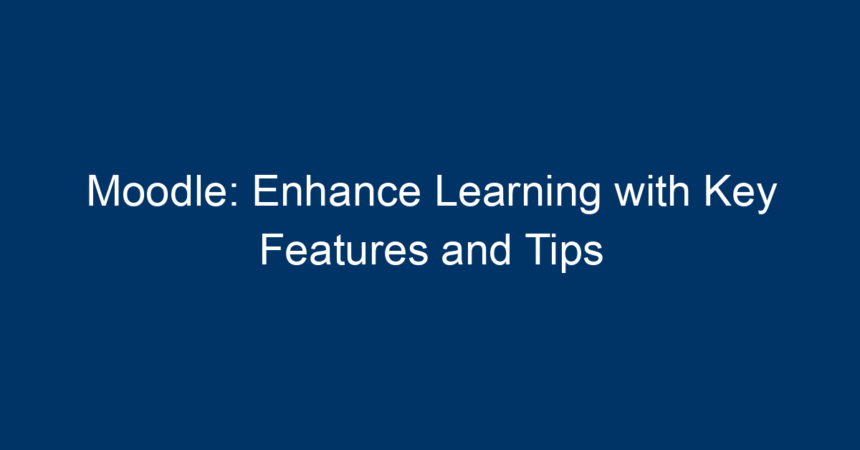In the ever-evolving landscape of online education, platforms that enable effective learning experiences are more crucial than ever. One such platform is Moodle, which has emerged as a leader in the realm of Learning Management Systems (LMS). With its open-source nature and customizable features, Moodle provides educators with the tools they need to create engaging and effective learning environments. In this article, we’ll explore the key features of Moodle, tips for maximizing its potential, and actionable insights that can help learners and educators alike.
What is Moodle?
Moodle is an open-source Learning Management System designed to provide educators, learners, and institutions with a single, secure, and integrated system to create personalized learning environments. Its flexibility allows for a wide range of educational activities, including forums, quizzes, assignments, and interactive content. Moodle is widely used in academic institutions, corporate training, and various educational environments, providing a reliable solution for anyone seeking to enhance learning experiences.
Key Features of Moodle that Enhance Learning
1. User-Centric Design
Moodle prioritizes user experience with its intuitive and user-friendly interface. Both educators and learners can navigate the platform easily, making it accessible for users of all technological proficiencies. The dashboard can be customized, allowing users to prioritize their most-used functions, which enhances the overall learning experience.
2. Customizable Learning Paths
One of the standout features of Moodle is its capability for personalized learning paths. Educators can design courses that cater to various learning styles and paces. Using the conditional activities feature, teachers can create branching paths where learners can progress through modules based on their mastery of the previous content. This personalization not only enhances engagement but also ensures that each learner can absorb information at their own pace.
3. Robust Assessment Tools
Assessment is a crucial aspect of the learning process, and Moodle excels in this area with its diverse range of assessment tools. From quizzes to assignments and peer assessments, it offers various methods to evaluate learner performance. Educators can use automatic grading features for quizzes, saving time and allowing for immediate feedback.
Moreover, Moodle supports a variety of question types, including multiple-choice, true/false, and essay questions, providing flexibility in assessment design. This functionality not only streamlines the assessment process but also helps in maintaining educational standards.
4. Interactive Learning Activities
Moodle encourages interactive learning through features such as forums, wikis, and glossaries. These collaborative tools promote communication, peer interaction, and cooperative learning among students. Forums, for example, allow for discussions where students can express their ideas and opinions, thereby enhancing critical thinking and engagement.
The integration of multimedia, such as video, audio, and images, further enriches the learning process. Educators can create dynamic lessons that cater to various learning preferences, making the content more accessible and engaging.
5. Comprehensive Reporting and Analytics
Data-driven insights are vital for improving educational approaches. Moodle offers comprehensive analytics and reporting tools that provide educators with valuable information about learner engagement and performance. By analyzing these metrics, educators can identify trends, address knowledge gaps, and enhance instructional methods.
Moodle’s report features allow for the monitoring of individual student progress, which can be instrumental in tailoring support and resources to those who need them most.
6. Mobile Compatibility
In today’s mobile-centric world, having a learning platform that is accessible on various devices is essential. Moodle supports mobile learning through its dedicated app, making it easier for learners to access course materials, participate in discussions, and complete assignments on the go. This mobility ensures that learning can happen anytime, anywhere, fostering a more flexible and accessible educational environment.
7. Community Support and Plugins
Being open-source, Moodle benefits from a vibrant community of developers and users. There are thousands of plugins available for enhanced functionality, ranging from additional assessment tools to interactive content features. This extensibility means that educators can customize their Moodle experience to fit their specific needs, providing an added layer of personalization.
Tips for Educators to Maximize Moodle’s Potential
1. Engage Students Early
Encourage early engagement by introducing learners to Moodle features at the outset. Conduct an orientation session or provide tutorial resources to familiarize students with navigating the platform. This can significantly enhance the confidence of new users and foster a positive learning experience.
2. Utilize Various Content Formats
Diversifying content delivery is essential for catering to different learning styles. Use videos, podcasts, and interactive quizzes to keep the content engaging. This approach ensures that learners remain interested and helps reinforce learning through various formats.
3. Create a Safe Learning Environment
Fostering a positive and safe online environment encourages student participation. Clearly outline guidelines and establish a code of conduct for discussions. This encourages respect and promotes a culture of learning where students feel comfortable expressing their thoughts and questions.
4. Monitor Progress Regularly
Utilize Moodle’s reporting features to track student progress consistently. Regular monitoring can help you identify struggling students early on, allowing you to provide timely support and resources that can help them succeed.
5. Encourage Collaborative Learning
Make full use of Moodle’s collaborative features. Consider group projects, peer assessments, and discussions to promote teamwork. Collaborative learning enhances problem-solving skills and enriches the educational experience by allowing students to learn from each other.
Actionable Insights for Learners
1. Explore the Platform
Take the initiative to explore Moodle’s features. Familiarize yourself with the dashboard, course materials, and assessment tools available. Understanding how to navigate the system efficiently can save time and enhance your learning experience.
2. Participate Actively
Engagement is key. Participate in forums, interact with peers, and contribute to group discussions. Active participation not only helps reinforce your understanding of the material but also fosters a sense of community among learners.
3. Set Personal Goals
Set clear goals for what you wish to achieve in your courses. Whether it’s mastering a specific topic or improving your grades, having measurable goals can keep you motivated and focused.
4. Utilize Resources Effectively
Take advantage of the resources provided by your educators. Download materials, watch instructional videos, and review assessments to strengthen your understanding. Don’t hesitate to reach out for help if needed.
5. Provide Feedback
Provide constructive feedback on courses and materials. This not only helps instructors improve their content but also fosters a culture of communication and improvement in the learning environment.
Conclusion
Moodle is a powerful tool that can significantly enhance the learning experience for both educators and students. By leveraging its extensive features and capabilities, educational institutions and learners can create engaging, effective, and personalized learning environments.
Whether you’re an educator looking to maximize your teaching strategies or a learner aiming to get the most from the platform, utilizing Moodle effectively is key. With regular engagement, diverse content formats, and a community-oriented approach, the potential for enriched learning experiences is limitless. Embrace Moodle today and transform the way you educate or learn, paving the way for a brighter educational future.
By understanding and implementing these strategies, you can truly make the most of what Moodle has to offer, contributing to not just individual success but a thriving educational community.




